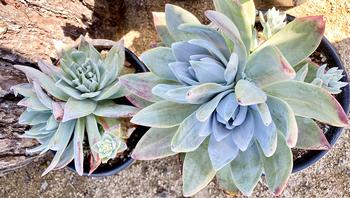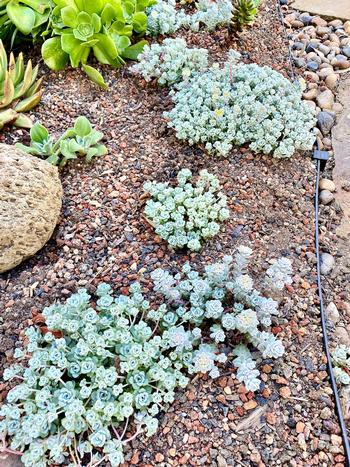Marin County’s beautiful native succulents
-
Barbara Robertson
-
When I first considered adding a native plant to my garden, the word “succulent” didn’t spring to mind. It does now. Succulents native to California range in size from tiny ground covers to the high desert Joshua Tree, and 25 are commonly available in nurseries. Many are cacti, agave, and yucca native to southern California, but Northern California has some, too, including the pretty subalpine Lewisia cotyledon with its clusters of pink-orange petalled flowers, nine Dudleya species, and two sedums. Two succulents are Marin County natives.
 The Marin native Dudleya farinosa is now protected from poaching and has become more available commercially. Plants courtesy CNL Native Plant Nursery.
The Marin native Dudleya farinosa is now protected from poaching and has become more available commercially. Plants courtesy CNL Native Plant Nursery.And those two succulents are wonderful. So wonderful, in fact, that one, Dudleya farinosa, became a target for avaricious poachers who combed the Marin, Sonoma, and Humboldt County coastal cliffs. The other, the tiny, less coveted but no less beautiful Yellow Stonecrop (Sedum spathulifolium), grows throughout Northern California. Both are appropriate for home gardens and you can find them in local native plant nurseries and other nurseries that carry succulents and native plants.
First, the tiny Yellow Stonecrop also known as Broad-leaf or Spoon-leaf Stonecrop. “Yellow” describes the diminutive flower petals, not the ground cover’s small rosettes. Broad-leaf and Spoon-leaf describe the tiny, thick, spade-shaped leaves. In spring and summer, flowers shoot up from the rosettes on erect stalks. There are numerous Sedum spathulifolium cultivars, but the elegant Cape Blanco and Purpureum are widely available. Cape Blanco has pewter / grey-blue leaves. Purpureum has reddish-purple / silver leaves. Both cultivars received the Royal Horticultural Society’s Award of Garden Merit. The tiny Marin native succulents Yellow Stonecrop (Sedum spathulifolium) Cape Blanco and Purpureum have blue-ish leaves and yellow flowers.
The tiny Marin native succulents Yellow Stonecrop (Sedum spathulifolium) Cape Blanco and Purpureum have blue-ish leaves and yellow flowers.These succulent ground covers could be a wise and beautiful choice for the area near buildings where it’s important to keep plants low and well-hydrated. Winter and spring rains alone can keep them hydrated all summer, although without any summer water the plants can shrivel. But, once established – that is, well rooted in the ground –the plants need water no more than once a month. The perennial, evergreen sedums spread at a moderate rate to create a mound that could reach three-feet wide. The plants are deer resistant, tolerate cold to 5 degrees, and are likely hosts to 10 butterflies and moths.
Dudleya is a genus of succulents in the same stonecrop family, crassulaceae, as the sedums Cape Blanco and Purpureum. There are 68 species and subspecies of Dudleya in North America of which about 50 live along hillsides from Southern Oregon to Baja, California. Many are on endangered species lists. Unfortunately, Marin County’s native, Dudleya farinosa, is not on those lists.
Thus, between 2017 and 2018, several people were arrested for poaching thousands of Dudleya farinosa, which had become a favorite of succulent fans in South Korea and China. The California Department of Fish and Wildlife estimated the harvested plants were worth in excess of one million dollars. Efforts spearheaded by the California Native Plant Society to propagate these plants has now put more Dudleya into commercial markets, and in September, 2021, Gavin Newsom signed a law making Dudleya poaching illegal with penalties for doing so.
Dudleya farinosa, commonly called bluff lettuce or powdery liveforever, typically has pale green leaves sometimes tipped with bright red, and grows well in pots. Like the sedum with which it co-exists and from which it evolved, Dudleya leaves form a rosette. But each spade-shaped leaf on Dudleya farinosa can be about two to two and a half inches wide and the plant can grow eight inches tall by a foot wide. In summer, a tall red stem with a cluster of red, yellow, or pink flowers atop attracts hummingbirds and other pollinators. In winter, Dudleya farinosa tolerates cold to 25-30 degrees.
Sedum spathulifolium and Dudleya farinosa can handle sun or part shade, but they must have fast-draining soil, especially in a shaded area with less evaporation. Plant them at an angle, water no more than once a month when established, don’t water from above, and you can enjoy these native Marin succulents in your own backyard.
Photos: Barbara Robertson


